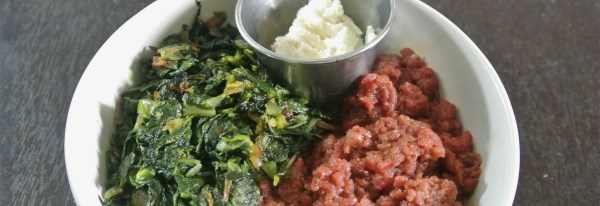
Kitfo differs for the standard fare found in most Ethiopian restaurants in America. A specialty of the Gurage people of Southern Ethiopia, this dish is now a popular throughout Ethiopia.
Ethiopian food within the U.S. typically showcases various types of stew (wat), sautéed dishes (tibbs) and the unique unleavened sourdough called injera. Kitfo, however, is distinct from these stalwarts of Ethiopian cuisine. It is neither stewed nor sautéed, served with specific side dishes, and normally not eaten with injera. The dish consists of lean minced meat flavored with aromatic spices and clarified butter, and typically is consumed raw. So how does it fit into our image of Ethiopian food?
Kitfo originates in the southwest of Ethiopia, a region known as the Southern Nation, Nationalities and Peoples' Region (SNNPR), from a cultural group known as the Gurage. The Gurage are an agricultural community that makes up only 2.5 percent of the total Ethiopian population, but still they have contributed to one of the most distinct and popular of Ethiopian dishes. The word Kitfo comes from the Ethio-Semitic root word meaning "to chop" or "to mince" and reflects the method of preparation for the dish. The dish shares flavors and ingredients with other Ethiopian food, but offers a distinctly Gurage way of eating.Kitfo Kitfo is a marvelous example of how food and ceremony become intertwined. For the Gurage, cattle are raised for butter and dairy production and therefore rarely eaten. Exceptions are made for celebrations or feasts, such as the Meskel, the festival of the True Cross, which is a religious festival for Ethiopian Orthodox Christians. Just like a classic Western tartare or crudo, the key to kitfo is using the highest quality raw meat.Kitfo he Gurage people's Kitfo is heavily spiced with mitmita (a blend of spices, salt and firey African bird eye peppers) and niter kibbeh, a spice infused clarified butter used in many Ethiopian dishes. At a Gurage table, the minced beef dish is always accompanied by gomen kitfo (Collard greens), ayib (a dry cottage cheese), and kocho (bread made from the ensente plant, known as a "false banana"). The inclusion of kocho is unique to the Gurage diet and is typically not found elsewhere in Ethiopia. The ensente plant is a staple crop that is integral to the Gurage life. The pulverized and fermented trunk and stalk are used to create kocho. Trying to obtain ensente (which is native to Ethiopia) in San Diego is next to impossible, so I recommend substituting injera.Kitfo Items such as mitmita, niter kibbeh and injera can be purchased at Awash Ethiopian Restaurant and Market and for responsibly raised, high quality beef I would recommend the Heart and Trotter Butcher Shop, which are across the street from each other.
Ingredients:
Niter Kibbeh:
- 8 tbsp unsalted butter
- ¼ tsp nigella seeds
- ¼ tsp fenugreek seeds
- ¼ tsp black cardamom, inner seeds
- ¼ tsp ajwain seeds
Gomen:
- 1.5 lbs collard greens (can substitute with kale or spinach), washed, stemmed and chopped very fine
- 4 tbsp Niter Kibbeh
- 1 medium yellow onion or 3 large shallots, minced
- 3 cloves garlic, minced
- 1.5” ginger, peeled and minced
- 2 red Thai bird eye chilies (can substitute with piri-piri peppers, mitmita or 3 fresh hot red chilies)
- White wine vinegar or lemon juice, to taste
- Salt and pepper, to taste
Kitfo:
- 1 lb lean beef (loin or top round)
- 2 tbsp (or to taste) Niter Kibbeh
- 1 tbsp mitmita
- 1 tsp ground coriander
Ayib:
- 4 cups whole milk
- 1/3 cup lemon juice
- salt, to taste
Preparation:
Niter Kibbeh:
- Melt the butter in a saucepan over low heat.
- Allow the butter to melt and clarify, uninterrupted. The butter will be ready once it is clear like ghee and completely liquefied.
- Coarsely grind the spices together in a mortar or a spice grinder and add to the clarified butter. Fry the spices, stirring to prevent burning, until fragrant, 1-2 minutes.
- Remove the saucepan from the heat and allow the mixture to rest and cool for 10 minutes before straining any residual solids.
Ayib:
- Add 4 cups of milk to a 2 quart saucepan and bring to a boil over medium high heat. Stay vigilant, as the milk has a tendency to over boil.
- Once the milk comes to a boil, reduce the heat and add the lemon juice, stirring constantly.
- Drop the heat to low, stir and simmer until the curd begins to separate from the whey.
- Once the curd separates, spoon the curd into a fine mesh sieve or strainer lined with cheesecloth. Gently run cold water over the cheese to remove residual lemon flavor.
- Place the sieve over a bowl, cover and refrigerate overnight, allowing any residual water to drain from the curd. The next day, place the cheese into a bowl and season with salt to taste.
Kitfo:
- Using a sharp knife, slice the beef thinly against the grain. Proceed to mince the meat by cutting the slices into thin strips (1/16th - 1/8th in) and then cutting the strips into cubes.
- Once the meat is minced, set aside.
- In a small pan, add niter kibbeh, mitmita and ground coriander. Heat the mixture over low until the butter is just warm and melted and the spices have infused.
- Once infused, remove the pan from the heat and add the meat.
- Stir to evenly coat the meat with the spiced butter. The traditional method is to mix the meat and butter by hand, although using a flexible spatula or a spoon works well. Traditionally the meat is served raw. (Note: For Kitfo leb leb, the partially cooked version, add the meat to the pan while on the heat. Cook until the meat is rare, 30 seconds.)
Gomen:
- Bring a pot of water to a boil and season with salt.
- Add the chopped greens to the water and simmer for roughly 15 minutes, until tender.
- Drain the collards and squeeze out any remaining water.
- On medium heat, melt the niter kibbeh in a small pot.
- Add the onion and sweat over medium-low heat until soft and golden brown, 10-15 minutes. (Note: Ideally the onions will be almost disintegrated. This will help to flavor the stew and contribute to the texture of the dish.)
- After the onions are golden and soft, add garlic, ginger and peppers.
- Saute ingredients until fragrant, about 3 minutes, taking care that nothing sticks to the pot.
- Add collards to the pot and saute, stirring to combine.
- Once collards are heated through and color has mellowed, remove from heat and stir in vinegar. Serve hot.
Eating:
This dish, like most Ethiopian food, is typically eaten with the hands. Using injera, scoop up a bit of kitfo mixed with gomen and some ayib. Alternatively, spooning one or all three items onto a piece of injera is easy and slightly less cumbersome for those not used to eating without western utensils.
Recipe and photo by: Liam Fox








